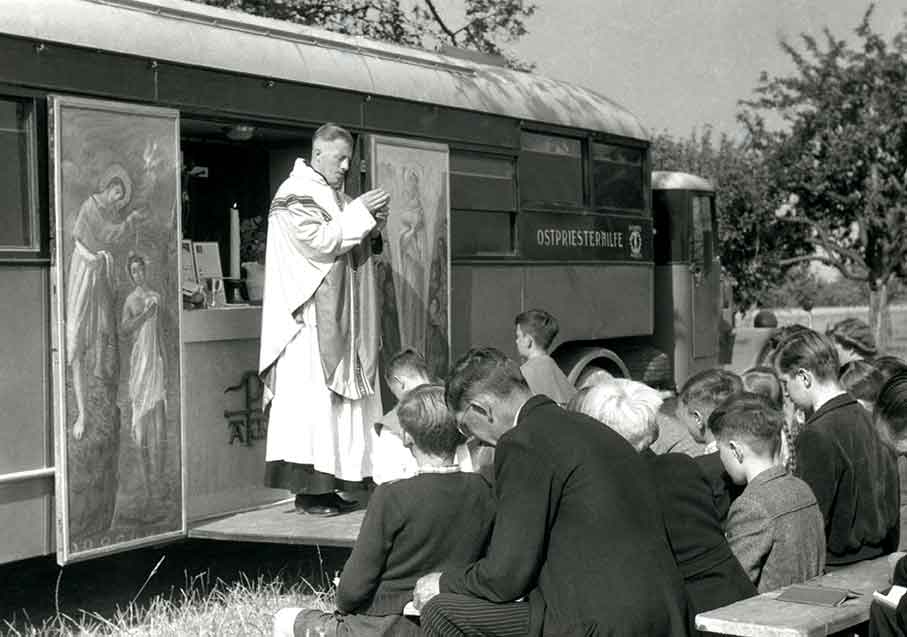“Vehicles for God” was the motto of a fundraising campaign initiated by the pontifical foundation Aid to the Church in Need (ACN) three quarters of a century ago. The aim was to procure motorcycles and cars that would be used to administer pastoral care in remote areas. In this interview, Regina Lynch, Executive President of ACN, talks about the beginnings and development of this special form of aid, which is as relevant today as it was back then.

What was the impetus for initiating the “Vehicles for God” campaign?
The campaign has its roots in Germany. After World War II, the country had been reduced to rubble. There was no infrastructure to speak of and the Church was no exception. Many displaced Catholics were now living in the diaspora and priests worked hard to remain in contact with their parishioners. They were known as “rucksack priests” and they had to cover unbelievably long distances. We know of priests who travelled for days on foot or on bicycle. They were absolutely exhausted. Father Werenfried van Straaten recognised how desperate their situation was and asked himself: “What can we do right now to help these people?”
What happened then?
First, money was collected to buy motorcycles for the priests, later VW Beetles. A large number of used cars were also donated to the campaign. This was followed by the idea to convert decommissioned buses, or semi-trailer trucks, into “chapel trucks”.
What were these “chapel trucks”?

Chapel trucks were semi-trailer trucks with converted trailers. One side wall of the trailer could be folded out to reveal an altar that had been installed in the interior. This altar was used to celebrate Holy Mass when the priests visited Catholics in areas without a Catholic church. The trucks were also used to transport donations of clothing and food. The chapel trucks were extraordinary and had a huge impact. They showed the displaced Germans in the diaspora that they had not been forgotten.
Aid to the Church in Need soon expanded its activities to provide aid for Christians behind the Iron Curtain and then to the entire world. What challenges did the organisation face in these areas?
Not all of these countries were in the same state of complete destruction as Germany was after World War II. However, in these countries, workers of the Church often had to – and still have to – cover huge distances, in many cases on roads that are in very poor condition. ACN has financed the purchase of motorcycles, cars and even boats. Instead of having to walk, priests and religious sisters are able to drive to their communities.
What is the situation today?
In Africa and Latin America, for example, some pastoral care workers are responsible for 50 or even 100 villages. Of course they are not able to visit them every day, but with access to a car, van or motorcycle they are able to visit each parish several times a year to celebrate Holy Mass, baptisms or hear confessions. In between these visits, catechists prepare the faithful to receive the sacraments and organise parish life.
Does ACN use different approaches in different countries? After all, a car is not the most effective means of transportation everywhere.

In many places, the roads are so poor that you can’t travel on them by car. Motorcycles are essential in these cases. There are also parishes that lie along rivers such as the Amazon, which means that local priests need boats to reach their communities. And in the Andes, where the paths are very steep, we have occasionally financed the purchase of mules or donkeys for religious sisters. The local Church adapts to local conditions, and ACN likewise adapts its aid to reflect local needs.
Pastoral care is essential in regions ravaged by war and natural disasters. Does ACN also receive special requests?
A current example is the war in Ukraine. Soon after the war broke out, we received requests for vehicles that would enable Church workers to transport relief supplies, bring people to safety or visit their parishioners, who live scattered across the country. Small buses are more suited for this than cars. Another example is northern Nigeria, even though many clergy have been kidnapped, priests still want to go out and visit their parishes. They used motorcycles for this in the past, but that has become too risky. And so the bishop asked us if we would finance the purchase of a car.
How much does ACN currently invest in vehicle aid?

We don’t have all the figures for 2023, but the total will probably be about the same as the previous year, when we financed the purchase of 1,250 vehicles for use in pastoral care, including more than 560 cars and 250 motorcycles, 16 boats and also a large number of bicycles. We donated more than 400 bicycles in India, for example, to help catechists who have to cover very long distances. Each year, the organisation spends about 12 million euros on vehicle aid.
